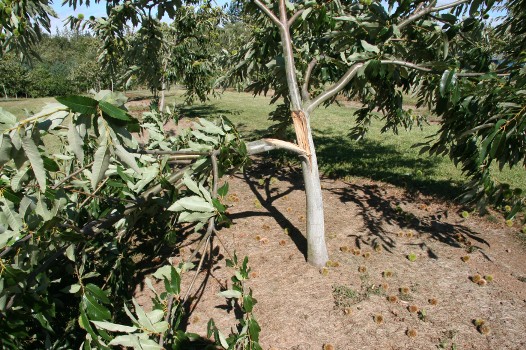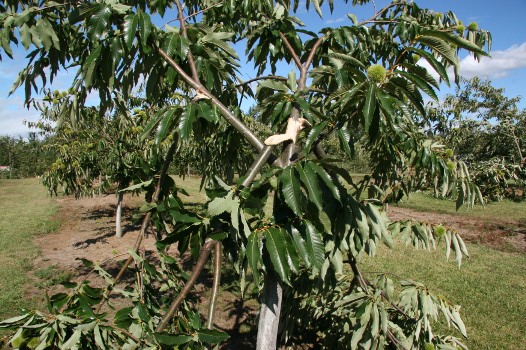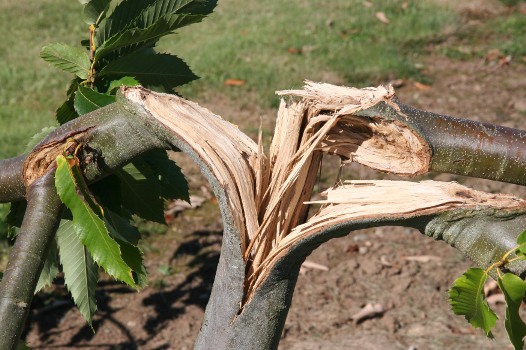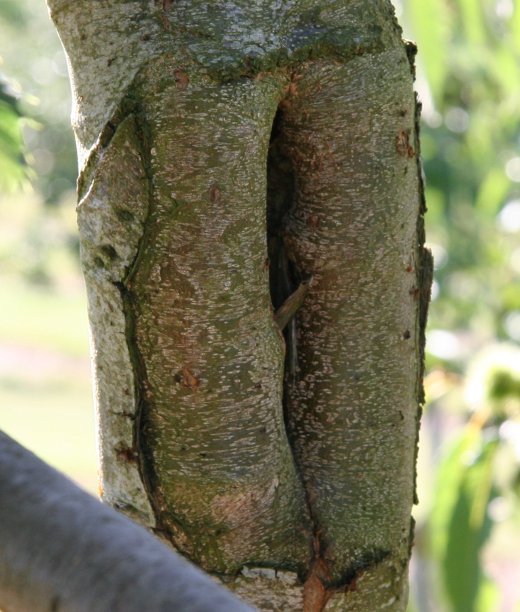| |
In our quest to be the best, the tallest, the most recognized, the pillar
that all look up to, we set ourselves up for a possible fall and chestnut
trees, like us, rise up to the sky with stature and grace as they age. Like
most things in our world, and following the age old warning, "What goes up
must come down", chestnut trees do fall to the ground in failure. For the
chestnut producer, the failing chestnut tree is the ultimate in losses: lost
production, lost years of tender care, lost stature and grace, and a big
hole in the orchard.
The rise and fall of anything in our world is dependent on many conditions
either supporting the rise or contributing to the fall. The rise of a
chestnut tree, like most living plants, has moisture, sunlight, and nutrient
requirements. But the lack of these are the least likely to be the primary
factor in a tree failure. At the top of the list of the things that are
likely to take down a chestnut tree to the ground is disease; next is
predation, closely followed by environmental factors. Environmental factors
can be things like: herbicides, accidental cutting, excessive temperatures,
and winds.
To properly mitigate the conditions that can cause a chestnut tree to fail, we
should look at those conditions that can be avoided and the conditions that
end up being unmitigated risks. Unmitigated risks end up being the risks with
the least chance of happening and have the least chance of economic loss. It
is easy to mitigate against losses due to herbicides and accidental cutting
by being careful with equipment in the orchard. Excessive temperatures can be
mitigated by not planting chestnut trees were the winters are to cold or the
summers to hot. Damage or loss of trees due to winds can be mitigated to a
much lesser degree than any other factors. Even using the best pruning and
tree forming strategies will not entirely protect chestnut trees from wind
damage. Also, chestnut trees enter a critical stage about 45 days before
harvest until the chestnuts have fallen from the tree. It is during this time
the braches are fully loaded with heavy burrs and all the leaves are still on
the tree that the chestnut trees can be broken by even minor winds of
15 - 20 MPH.
If we can not mitigate losses entirely we will have to plan on them in our
business model. Since our focus is on producing chestnuts, the portion of the
business model that needs attention is the production
section. The production section is a forecast of the expected number of
pounds of nuts produced in a given harvest season. A basic calculation of:
P=T x N can work where P is production in pounds, T is the number of trees
producing in the orchard and N is the average number of pounds of nuts per
tree. Let.s see how we can modify this equation to incorporate the losses
from wind damaged trees: P=((T-D) x N where D is the number of damaged trees.
But this is a little over simplified because not all trees damaged by wind
lose 100% of the nuts for that year. Some trees can lose anywhere from a
small branch representing less than 5% of the tree to 80% or more of the
tree. Let.s say an orchard consists of 200 trees producing an average of 7
pounds of nuts per tree. Just before harvest winds cause damage to some of
the chestnut trees. Two of the trees are complete losses, 5 trees have 50%
losses, and 5 trees have 30% losses. The equation for calculating total
production to adjust for these losses can be made like this:
P = (T - (2 + (5D x 0.5) + (5D x 0.30)) x N
P = (200 - (2 + 2.5 + 1.5)) x 7
P = (200 - 6) x 7
P = 194 x 7
Production in pounds = 1,358
Now let's add a margin of error of 15%.
Max production = 1358 + (1358 x 0.15) = 1,561.7 pounds
Minimum production = 1358 - (1358 x 0.15) = 1,154.3 pounds
Now we can say production should be at least 1,154.3 pound and possibly as
much as 1,561.7 pounds. The difference between the two is about 400 pounds.
Only you can decide how to work in the 400 pounds in your business and
marketing plans. If you sell your production to a co-op then this effort is
almost meaningless. If your plans include many destinations then an ongoing
up to date production estimate is very important.
Could better pruning practices, selecting different types of chestnut trees,
changing the soil amendments, changing the amount of water the trees receive
in the dry season be effective in increasing production by reducing the
loses to tree damage? All of these ultimately reduce the total production
in the orchard. With the calculated loss of 6 tree times the 7 pounds per
tree results in a total loss of 42 lbs. This is only about 10 percent of the
margin of error. In the big picture where total expected production is 1,358
pounds, the loss of 42 pounds is only 3 percent of the expected production
before the damage to the trees. If you lost 8 customers who wanted to buy
chestnuts from you because of the losses, then the 42 lbs is meaningful.
If we choose to try to mitigate losses by increasing the care of the chestnut
orchard we will end up with diminishing financial returns and possibly losses.
The math starts getting complicated so let's just say it is unlikely the
chestnut orchard in the example from above would benefit more than the 3
percent loss by increasing inputs. If more care will not help, then what
happens to damaged chestnut trees?

Here is a chestnut tree with a broken limb representing a loss of about 30
percent of the nut production. After ingesting this heart wrenching event,
sobbing our sorrows endlessly, counting our losses, and wondering what's
next for us in life, we have do deal with this disaster. Being that chestnut
trees are part of the oak tree family, the greatest likelyhood is that this
chestnut tree will develop character and stature, like the war wounds of our
veteran heros and a form similar to a scrub oak tree.

This chestnut tree pictured above lost the top structures in a wind storm.
Would proper pruning prevented this from happening? Would a different type/
cultivar chestnut tree made a difference? Both cultivar selection and pruning
may have helped prevent this failure at the top of the tree, or maybe not.
Knowing what may or may not happen is a speculation or a guess. If
speculation is desired, then it is speculated that pruning 1/3 of the annual
growth for the first 5 years would have made the primary branches much
stronger, able to stand up to the strongest of winds. Or maybe nature will send
much stronger winds next week, next year, or 10 years from now. Maybe the best
question is "Are you the type that prevents disasters, or are you the type of
person that just deals with disasters?".

Here is a disaster, not one waiting to happen, not one hidden from plain sight,
not one that can be neatly swept off to the side of the road, no the chestnut
tree in this photo is almost a total loss. The reason it is not a total loss is
because chestnut trees will sucker from the roots. The next growing season this
chestnut tree will send up suckers from the base of the tree and from these
suckers a new tree will shoot up. For a chestnut producer the top performing
sucker will be used to regraft this tree to make the use of the root
structures already present. A good graft could grow 6 or more feet in the first
season and in the second season after the grafting start producing nuts.

Given some time chestnut trees will heal over lost limbs and broken tops. In
this photo the chestnut tree has had 2 seasons to heal over the loss of a
branch. In another growing season the healing should be complete adding to the
character of this fine chestnut tree.
|
|
|
|
Contact Information:
Farm Location:
6160 Everson Goshen Rd
Everson, WA 98247
Ph: (360) 592-3397
Business Offices:
Washington Chestnut Company
6160 Everson Goshen Rd.
Everson, WA 98247
Ph: (360) 592-3397
|
|




